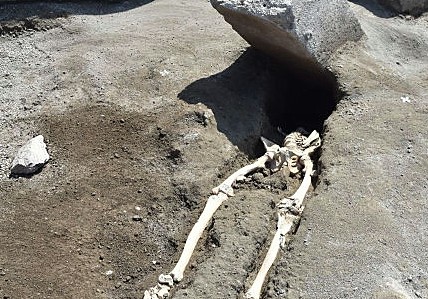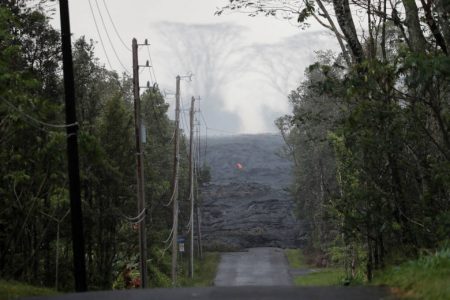May 31, 2018 – I was watching the BBC World News last evening and saw a headline scroll across the bottom of the screen stating that a man in Pompeii was crushed by a boulder fleeing an eruption. It didn’t say that a new dig had unearthed a skeleton pinned under a large stone, possibly from a nearby building, that was violently thrown into the air during the explosion of Mt. Vesuvius in 79 A.D. Rather it read like a current headline. Had Vesuvius erupted again? Had a tourist or guide in the ruins been whacked by a volcanic bomb?
In the age of “fake news,” I immediately thought about just how far our news media had descended in its ability to report reality. Going online it became clear to me as I scoured other news sources and did a Google search that the headline was describing a historic find. A new dig at the site of Pompeii had unearthed this story with lots of interesting details. Apparently, the victim of this skull-crushing episode was determined to be over 30 years of age. And the explanation of why he may have been a victim could be seen in one of his legs which had a bone infection making it difficult for him to walk.

In university, as part of my undergraduate studies, I spent a considerable amount of time studying the late Roman Republic and Roman Empire. It helped me to better understand European, North African, Middle Eastern and Asian history as I pursued a degree in Medieval History and Islamic Studies. The tragedy of Pompeii as recorded by Pliny, the Younger, was required reading.
The Story of Pompeii
If you are not familiar with Pompeii, this seaside resort town near present-day Naples, hugged the flanks of Mt. Vesuvius. It was the vacation home of many in the Roman Senate including Pliny’s father who died during the eruption. On that fateful day, August 24, 79 A.D., Pompeii and the neighbouring town of Herculaneum were suddenly buried by a rain of pumice, ash, and mud accompanied by pyroclastic explosions of superheated gases that raced down the mountain slopes killing every living thing in their path. Boulders hurled by and from the mountain even struck ships in the Bay of Naples, kilometers away from the epicenter of destruction. Pliny, the Elder, was on one of those ships and died after it was struck by volcanic debris. Vesuvius had been dormant during the rise of Rome. There was little forewarning of a pending eruption. The two towns, Pompeii and Herculaneum, lay buried and forgotten only to re-emerge as archaeological interest in the sites began in the 18th century. Today, the uncovered sections of these preserved towns provide a rare glimpse into the life of those who lived and died in the first-century Roman Empire.

Should this tale of woe make humans living near volcanoes smarter?
In the past few weeks, we have been watching Kilauea, in Hawaii, (see picture above) as it erupts sending rapidly advancing lava flows across roadways and into neighbourhoods, cutting off escape routes for residents. Some people refuse to leave their homes in the path of oncoming lava. Some have had to be rescued at great cost. It seems the lesson of Pompeii which goes back more than 1,900 years is lost on them. And maybe we can be forgiven for not paying attention to something that happened so far back in time, but even Vesuvius has erupted 27 times since 79 A.D. and today, Naples, Italy, a city of 3 million sits just 12 kilometers (7.5 miles) from the mountain peak. A significant eruption in March 1944, during the Second World War, buried two small towns on the volcano’s flanks. And since then a couple of minor incidents have spooked volcanologists. By minor, we are using that term relativistically. It certainly didn’t appear minor, in 1998, when the mountain rained ash on a nearby town killing 150 people.
Which brings us back to Kilauea. So far, several thousand have fled local communities as earthquakes and lava flows have revealed we humans simply do not learn the lessons nature’s dark side delivers. The vicinity of volcanoes is simply not a safe area to inhabit. Modern monitoring may give us a sense of security but we still have a lot to learn about what causes some volcanoes to suddenly erupt while others behave predictably. In the case of Kilauea, defined by volcanologists as active, there . is a degree of certainty that it will erupt. But in the case of Vesuvius, defined as dormant, eruptions are sporadic and impossible to accurately predict.
Does it remain an acceptable risk to live near a volcano?
In the 21st century, around 1,000 people have died because of volcanic eruptions around the world. That’s a small number compared to those dying from disease, car accidents, and war. Being nearby volcanoes is seen by many to be an attractive place to live. The soils volcanoes produce are rich in minerals creating quality farmland. And so many volcanoes lying along the Ring of Fire that encircles our Earth, marking the edge of active tectonic plates, bring economic wealth to nation states. In Costa Rica, which my wife and I frequently visit, volcanoes are not only tourist attractions, but sources of geothermal energy to help provide reliable, renewable energy for the country. The same is true for Japan, Iceland, and New Zealand.
But there is acceptable and unacceptable risk. Take Naples as an example. The city’s latest emergency evacuation plan is designed to save 700,000 people in a 72-hour period. The areas to be evacuated are defined as “red zones.” The city is to deploy 500 buses and 220 trains to move the population out of harm’s way. But there also “yellow zones” where ash falls are likely to occur. These areas represent 63 districts within the greater Naples area and are not part of the evacuation plan. Yet, in 1998, as I have stated before, a sudden ash fall killed 150 people precisely within an area defined as a “yellow zone.” And to add another detail, what the Naples plan seems to have not learned from 1,900 years of history is that Vesuvius in 79 A.D. struck Pompeii and Herculaneum in a single day, 24 hours, not 72 hours. And the mountain provided no prior warning.
As for what inspired me to write this posting today, I want to assure my readers that no one died on the site of Pompeii from a volcanic eruption in the last week despite the headlines that appeared on the BBC in news feeds and on other media around the world.








